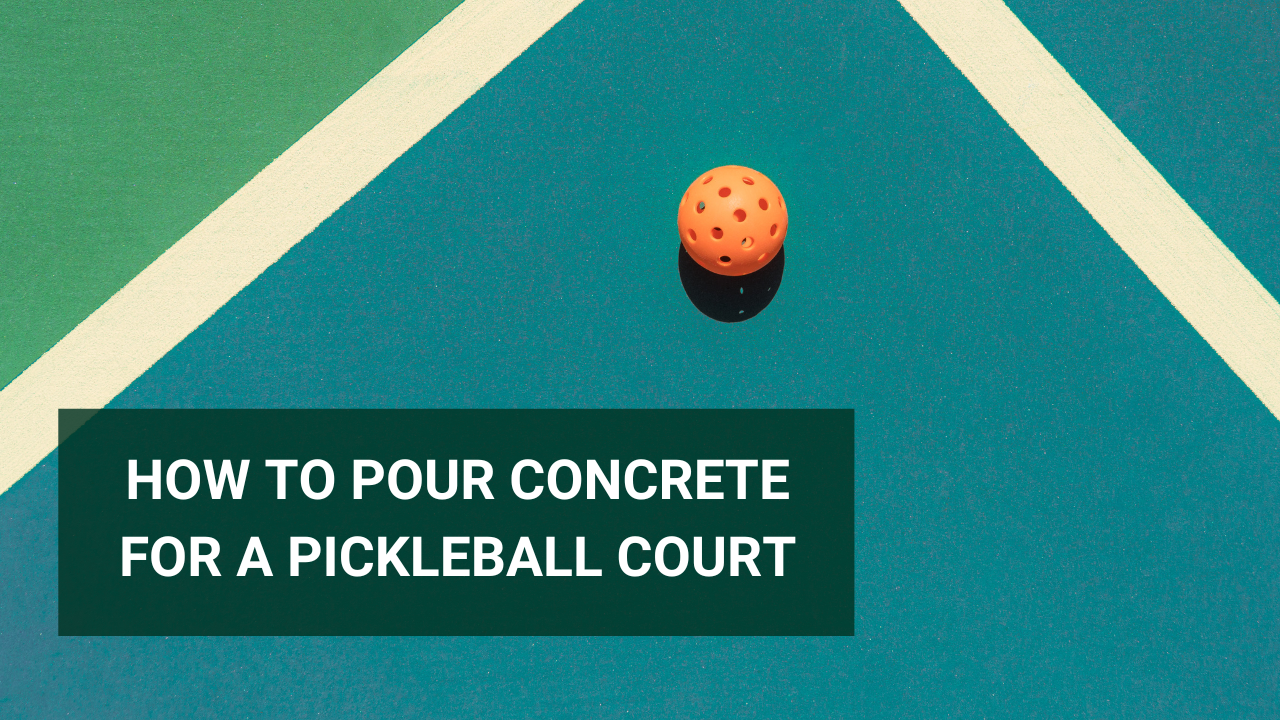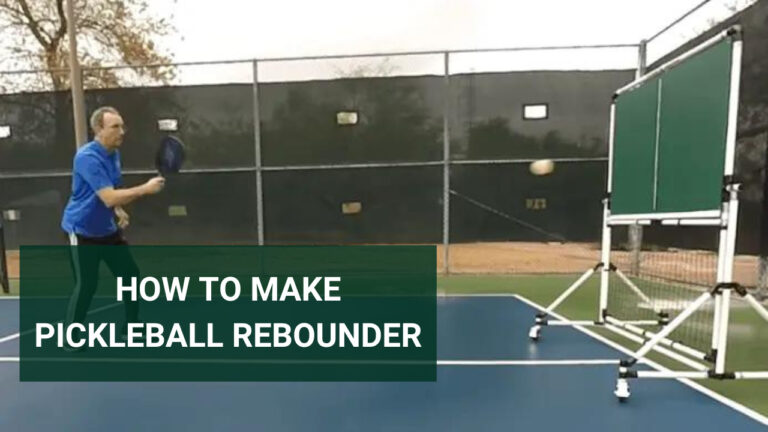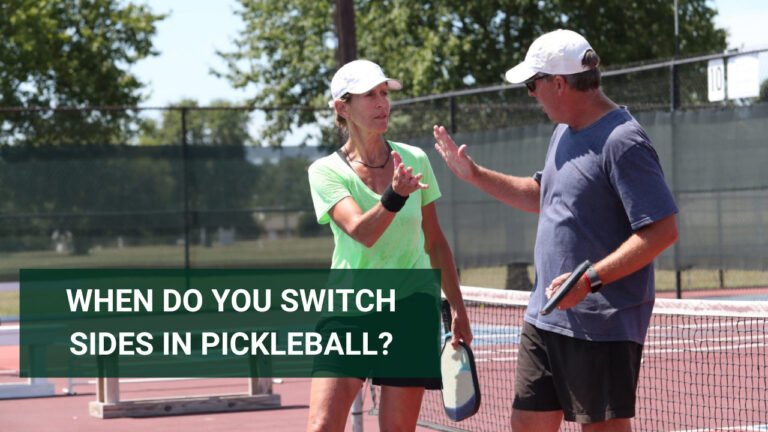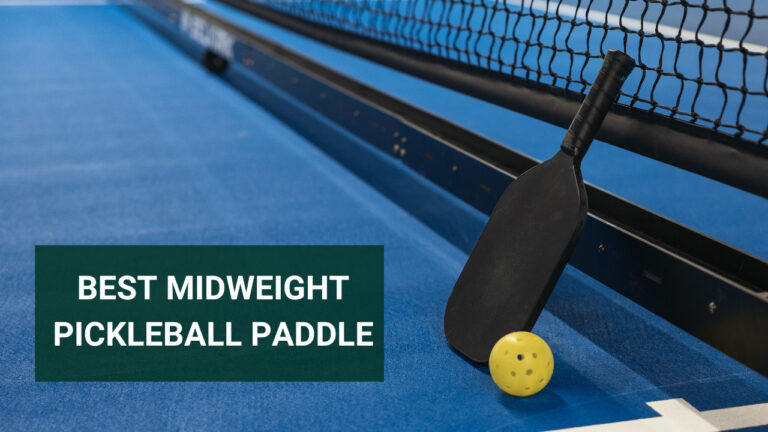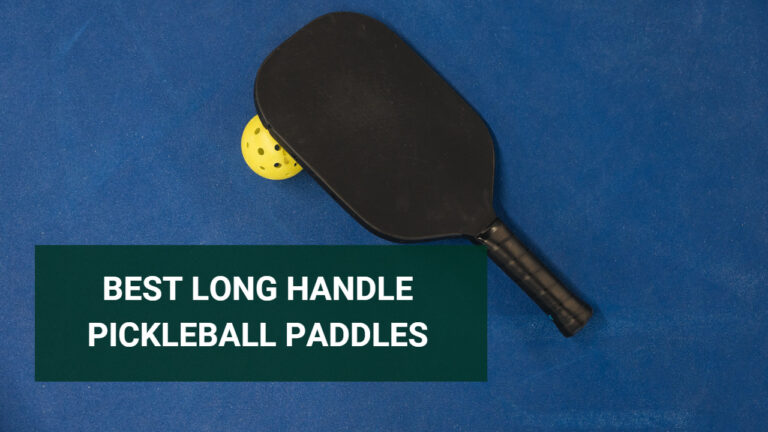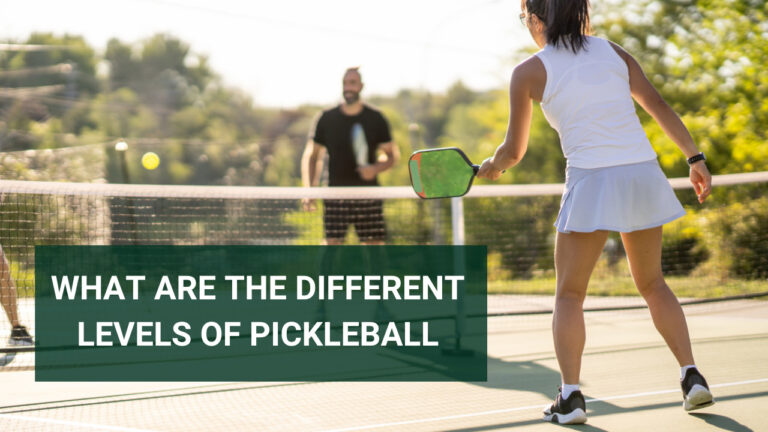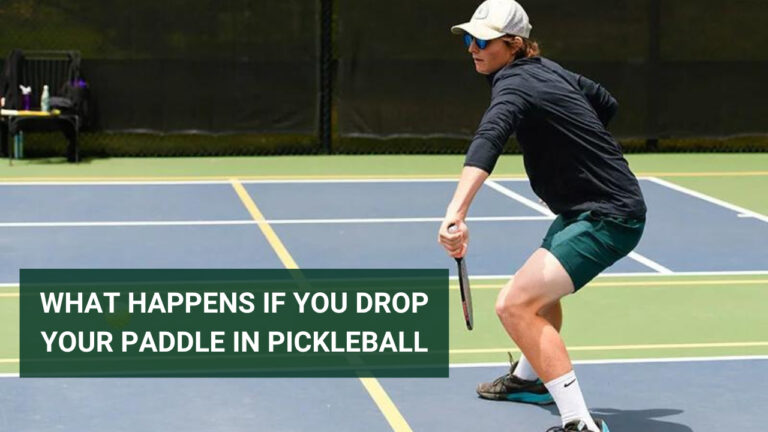How to pour concrete for a pickleball court – Step-by-Step Guide
Master the art of concrete pouring to create a flawless pickleball court that guarantees hours of fun and competitive play.
Are you a pickleball enthusiast looking to create your own court at home? One of the most crucial steps in building a pickleball court is pouring concrete.
The process of pouring concrete for a pickleball court involves preparing the site, creating a proper base, installing forms, pouring the concrete, and finishing the surface. It requires careful planning, proper materials, and skilled techniques to ensure a smooth and durable court.
In this step-by-step guide, we’ll walk you through how to pour concrete for a pickleball court so that you can enjoy playing on your very own backyard court in no time.
Let’s get started!
How To Pour Concrete For A Pickleball Court – Step By Step Guide
Here we will discuss steps to pour concrete for a pickleball court:
1. Preparing the Site
Hey pickleball enthusiasts! Before you dive into pouring concrete for your awesome pickleball court, there are a few crucial steps you need to follow. Let’s get straight to it:
- Clear the site: Make sure to remove any debris or plants from the area. We don’t want anything getting in the way when we lay down that concrete!
- Level and compact the ground: Use a compactor machine or a trusty hand tamper to flatten out any uneven spots. A smooth surface is key for a fantastic playing experience.
- Mark it out: Grab your chalk lines or spray paint and mark the dimensions of your court. Remember, we’re going for the official size of 20×44 feet, with a net height of 36 inches at the center court.
- Don’t forget drainage: Check if your site requires proper drainage. We want to avoid any water accumulation that could cause damage over time.
By following these steps and giving your site the attention it deserves, you’ll lay the groundwork for an incredible pickleball court. Get ready to enjoy some epic matches in no time!
2. Materials and Equipment
Hey fellow pickleball fellow! Let’s talk about the materials and equipment you’ll need to pour concrete and create an amazing pickleball court. Here’s what you should gather:
- Portland cement: This is your main ingredient for creating the concrete mixture. You can find it at your local hardware store or home improvement center.
- Aggregates: Get some gravel and sand to add strength and texture to your mixture. Make sure to get the right proportions for the best results.
- Water: You’ll need clean and impurity-free water to mix with the other components. Remember, quality matters!
- Mixing tools: Grab a mixer or a trusty wheelbarrow to blend all the ingredients together. This will ensure a thorough and consistent mixture.
And don’t forget about safety! Wear gloves and goggles to protect yourself from any skin irritation while working with concrete.
With these quality materials and proper equipment, you’ll be well on your way to creating a durable pickleball court that guarantees great playing conditions. Get ready for some awesome games ahead!
3. Concrete Mixing
Alright, let’s dive into the exciting part of creating our pickleball court – mixing the concrete! Here’s what you need to do:
- Get the right mix: Measure out the right amount of cement, sand, and aggregates according to the strength you need. Look for a high-quality mix designed for paving or sports surfaces.
- Gradually add water: Slowly pour in the water while stirring the mixture. Aim for a smooth consistency, but be careful not to add too much water as it can weaken the concrete.
- Mix it up: Stir everything together thoroughly for at least 5 minutes. This ensures that all the components are evenly distributed in the mix. If you’re working on a larger area, consider using a mechanical mixer for more efficiency.
- Time to pour: Once your mixture is well-mixed and ready, it’s time to pour it onto the formwork. Make sure it’s evenly spread out and level for a smooth playing surface.
Remember, a proper mix and thorough stirring are essential for a flawless finish without any cracks or weak spots. This will ensure a fantastic pickleball experience on your new court!
Let’s get that concrete mixed and ready for some epic pickleball action!
4. Formwork Installation
Alright, let’s talk about the important step of installing the formwork for our pickleball court. Here’s what you need to know:
- Get your measurements right: Make sure to accurately measure and mark out the dimensions of your court. This ensures that your pickleball court looks professional and has consistent dimensions.
- Choose quality materials: Opt for sturdy materials like plywood or steel for your formwork. This will prevent any warping or damage while pouring the concrete. Also, use strong stakes to securely hold the formwork in place.
- Check for level lines: Before joining the formwork together, use a laser level or spirit level to ensure that your court will have an even playing surface. This step is essential to avoid any uneven areas.
- Clean and prepare: Once the formwork is securely installed, take the time to clean out any debris from within the forms. This ensures a clean and smooth surface for the concrete.
By following these steps, you’ll be on your way to creating a solid pickleball court with a professional finish. Get ready for some intense matches and lots of fun on your new court!
5. Reinforcement Placement
Now, let’s talk about an important step in creating a durable pickleball court: reinforcement placement. Here’s what you need to know:
- Determine the size and spacing: Figure out the appropriate size and spacing for your reinforcement based on factors like slab thickness, expected load, and building codes. This ensures that your court will have the strength it needs.
- Lay out the reinforcement: Start by placing one layer of steel bars or mesh at a time. Make sure each piece overlaps with its neighbor by at least 6 inches. This overlapping helps create a solid and unified structure.
- Secure the reinforcement: Use wire ties or clips to secure the pieces together at the overlap points. It’s important to keep the reinforcement straight and level to maintain consistency and strength.
- Consider additional elements: If needed, add any extra reinforcing elements, such as dowels or anchors before you start pouring the concrete. These elements provide extra support in specific areas as required.
By properly placing the reinforcement, you’ll create a sturdy pickleball court that can withstand regular play without cracks or damage. Get ready to enjoy countless matches on your strong and reliable court!
6. Pouring the Concrete
Alright, let’s dive into the exciting part of building your pickleball court: pouring the concrete! Here are the key steps you should follow for a successful pour:
- Start pouring from one corner: Begin at one corner of the formwork and gradually work your way towards the opposite corner. This ensures that the concrete is evenly spread throughout the court.
- Use the right tools: Whether it’s a wheelbarrow or a pump, choose the most convenient method to transport the concrete from the mixer to the site. Keep the mixture well-mixed and ready for pouring.
- Pour the right amount: Fill each section of the formwork with the appropriate amount of concrete, making sure not to overfill. Use a screed board with straight edges to level off any excess and achieve smooth surfaces.
- Avoid interruptions: Once you start pouring, try to avoid stopping midway. This helps maintain a consistent color and texture, especially if you’re using different batches or there’s been a delay between the mixer and the site.
- Allow for proper curing time: After pouring, be patient and give the concrete enough time to cure before starting any other activities around the newly poured area. This ensures a strong and solid court surface.
By following these steps, you’ll be on your way to enjoying epic pickleball matches on a professionally poured concrete court. Get ready to show off your skills and have a blast playing the game you love!
7. Finishing and Curing
Once the concrete is poured for your pickleball court, it’s time to give it that final touch and let it reach its full strength. Here’s what you need to do:
- Smooth it out: Grab a bull float to even out any bumps or ridges on the surface. This tool works like magic, making sure your court is nice and flat. If you want an extra smooth finish, switch to a hand trowel for those final touches.
- Create clean edges: Edging is key to giving your court a polished look. Use an edger tool to create sharp and defined lines along the sides of your court. This not only adds a professional touch but also helps prevent any cracks from forming along the edges.
- Time to cure: Curing is crucial for the concrete to reach its maximum strength. Keep the moisture locked in during the early stages of setting. You can do this by covering the surface with plastic sheeting or wet burlap bags. This allows the concrete to develop its full strength over time.
- Patience is key: Give the concrete enough time to dry and cure properly before you start rallying on your new pickleball court. Rushing into playing too soon might compromise the quality and durability of the surface.
Once the concrete is finished, cured, and fully dried, you’re all set to enjoy some epic pickleball action on your brand new court. Get ready to serve, volley, and have an amazing time playing the game you love!
8. Post-Pouring Care
Once you’ve poured the concrete for your awesome pickleball court, it’s time to give it some extra love and care. Here’s what you need to do:
- Keep it covered: Apply a curing compound to the surface to keep it moist and strong. This helps prevent moisture loss and ensures that your court stays in top shape.
- Tread lightly: Avoid walking or driving on the fresh concrete as much as possible. We want to give it time to set and cure without any unwanted cracks or damage. So, let’s give it some space to do its thing!
- Watch the weather: Keep an eye on the weather conditions during the curing phase. Extreme temperatures or heavy rain can mess with the process. If things get dicey, take necessary precautions to protect your court.
- Unveil the masterpiece: Once the curing is complete, it’s time to remove any formwork that was used during construction. Take it off carefully, making sure not to harm any edges or corners. We want everything to look as perfect as our shots!
- Check for perfection: Give your pickleball court a thorough inspection. Look out for any cracks or imperfections that may have appeared during construction. If you spot any issues, take care of them promptly to avoid bigger problems later on.
By taking these steps to care for your pickleball court after pouring the concrete, you’ll be ensuring its durability and longevity. Get ready to grab your paddle, invite your friends, and have a smashing time on your very own court!
What do you need to pour concrete for a pickleball court?
Before you start pouring concrete for a pickleball court, it’s essential to ensure you have all the necessary materials and equipment.
- First of all, you will need to determine the size of your court and calculate how much concrete mix you require.
- Once you know how much concrete is needed, purchase high-quality cement, sand, gravel or crushed stone.
- It’s best to use a ready-mix concrete as it ensures uniformity in strength and quality.
- You’ll also need water and admixtures like plasticizers that improve workability.
- For equipment requirements, having a reliable mixer can make mixing easier with less manual labor involved.
- A wheelbarrow or small cart helps transport mixed concrete from the mixer to the site, while shovels are used to distribute it evenly across forms.
- Additionally, formwork tools like stakes and lumber help create an outline on which wet concrete is poured, while rebar or wire mesh provides reinforcement against cracking over time.
- Lastly yet importantly, safety gear should be worn, including gloves, goggles, and boots, so as not to endanger yourself during the construction process.
Conclusion
Pouring concrete for a pickleball court isn’t an easy task, but it can be done successfully with the right materials, equipment, planning, and preparation. By following our step-by-step guide, you’ll ensure a durable and long-lasting court.
Remember, taking care of the concrete after pouring is crucial. Give it enough time to cure before using the court regularly, and don’t forget to apply a sealant to protect it from moisture damage.
We hope our article has helped you navigate the process of pouring concrete for your pickleball court. With patience and attention to detail, you’ll create a smooth surface where you can enjoy this fun sport with your friends and family for years to come!
FAQs:
Can you play pickleball on a concrete surface?
Yes, you can play pickleball on a concrete surface.
What is the dimension of a pickleball court?
The dimensions of a standard pickleball court are 20 feet wide by 44 feet long.
How do you temporarily convert a tennis court to pickleball?
To temporarily convert a tennis court to a pickleball court, you can use portable pickleball nets and attach them to the existing tennis net posts. The court can be marked using removable tape or chalk to create the smaller pickleball court dimensions within the tennis court.
How do you make a portable pickleball court?
To create a portable pickleball court, use portable nets and mark the court boundaries with tape or chalk on a flat surface. Alternatively, you can use temporary lines or interlocking tiles designed for pickleball. These options provide easy setup and removal, making the court portable for play in different locations.
What is a pickleball ball called?
A pickleball ball is called a “pickleball.”
